A rich harvest of small plum-shaped tomatoes from each bush - the “Pink Raisin” tomato and the secrets of caring for it
Among the abundance of tomato varieties, pink, cherry and cream tomatoes are especially popular. The first ones were loved by domestic consumers for their rich sweet taste, the second ones for their miniature size, and the third ones for their dense pulp. And often gardeners are faced with the difficulty of choosing one of the presented options. In this case, the Pink Raisin tomato will be your salvation, combining all these qualities.
Pink raisins are attractive not only for their delicious miniature fruits, but also for their ease of care. It feels great in all regions of our country. How to grow this tomato in your garden and what difficulties beginner gardeners face - read on.
Description of the hybrid
Pink raisins are a first generation tomato hybrid. This is indicated by the mark f1. It was bred by crossing two parent varieties, so you cannot use seeds from independently grown fruits. They will grow into tomatoes with parental characteristics.
The hybrid was bred by Ukrainian breeders. It is not included in the Russian state register. Despite this, Pink raisins are popular and have positive reviews from gardeners in our country.
Distinctive features of Pink raisins
Pink raisins stand out among other tomatoes for their fruits, which combine the qualities of the most popular tomato varieties. The berries of this hybrid are pink in color and miniature in size. Their shape is elongated, so they resemble cream.
Tomatoes have a rich, sweet taste with a pronounced tomato aroma. The pulp is dense but juicy.
Another characteristic feature of the hybrid is the ability to set a large number of fruits. Up to 50 berries are formed on one brush.
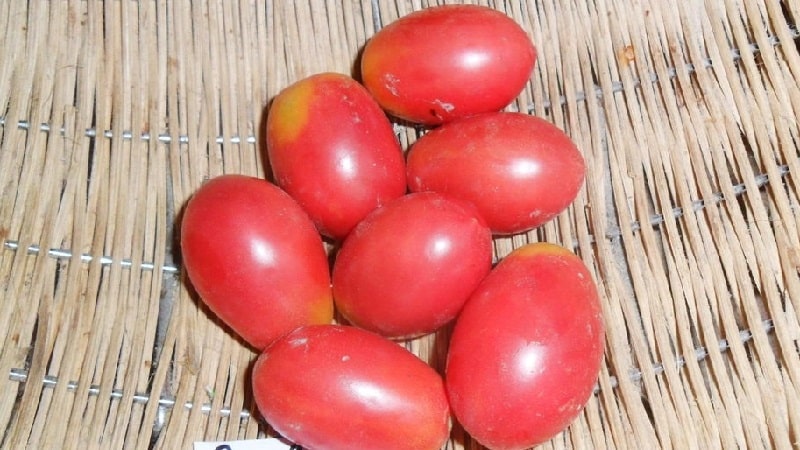
Characteristic
The description of Pink raisins will surprise even experienced gardeners. It is distinguished not only by early ripeness, high yield and excellent taste of fruits, but also by ease of care.
Characteristics of Pink Raisin:
| Parameter | Indicators |
| Bush type | Determinant, ends its growth with a flower brush. Does not apply to standard ones. The bush grows up to 1.3-1.5 m. The stems of the hybrid are strong, erect, and thick. Covered with medium amount of foliage. The bushes are spreading. The leaves are medium-sized, light green, wrinkled, without pubescence, typically tomato-like. Has complex intermediate inflorescences. The first inflorescence is formed in the axil of 6-8 leaves, the next ones - every 1 leaf. The fruits are produced in complex fan clusters. Each brush contains up to 50 berries. The peduncle has an articulation. |
| Growing method | Tomato is resistant to negative environmental factors. Suitable for growing in greenhouses and open ground. |
| Productivity | High. 6 kg of berries are harvested from 1 plant. From 1 sq. m manages to get up to 15 kg of tomatoes. |
| Fruit | Small cocktail tomatoes. The weight of one berry varies between 30-60 g. The length of the fruit reaches only 5-6 cm. The color is pink inside and outside. The skin is shiny, with a slight pearlescent appearance. There may be lighter and darker stains on the skin and light spots inside. The shape is elongated, smooth. The pulp is juicy and tender. The taste is sweet with barely noticeable sourness. Dry matter content – 5%.Each berry has 2-3 seed chambers. |
| Transportability | High. Pink raisins have a strong skin that protects the berries from cracking and other damage during transportation. Fruits can be stored for more than a month at room temperature. |
| Ripening time | Early ripening hybrid. The first harvest can be harvested 3 months after sowing the seeds. Fruiting continues until autumn. |
| Disease resistance | It is resistant to the most common diseases of nightshade crops and rarely suffers from late blight. |
Note! In the Pink Raisin tomato, more fruits are formed on the lower clusters. The higher the brush, the fewer berries it contains.
Growing seedlings
Pink raisin seeds are sown for seedlings 55 days before planting the plants in open ground. The beginning of growing seedlings depends on the climatic conditions of the region:
- southern regions – late February or early March;
- northern regions – beginning of April;
- temperate climate zone - second half of March.
If you plan to plant tomatoes in a greenhouse, sowing seeds begins 2 weeks earlier.
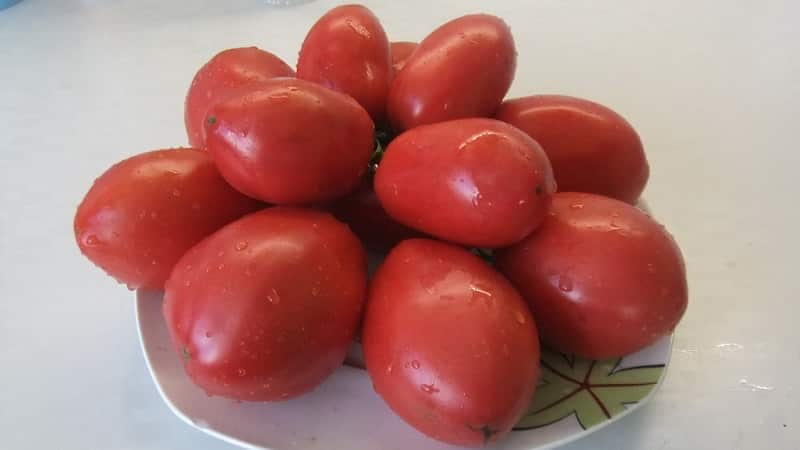
Processing of planting material
Pink raisin seeds are sorted. Darkened and damaged specimens are discarded. It is important to ensure that the seeds are not covered with mold.
Manufacturers often produce seeds that have been treated in a factory. Information about this is indicated on the packaging. Treated planting material is identified by its orange or light green color.
If seeds are not disinfected by the manufacturer, they are processed at home by soaking:
- for 30 min. in a weak solution of potassium permanganate;
- for 15 min. in hydrogen peroxide;
- for 12 hours in aloe juice.
Advice! Aloe juice, diluted half and half with water, not only disinfects the seeds, but also accelerates their germination. The most effective are products made from leaves older than 3 years.
After disinfection, the seeds are treated with a growth stimulator. This not only accelerates their germination, but also increases the immunity, cold resistance and endurance of plants.
To stimulate growth, purchased and homemade products are used. The list contains the most popular of them:
- "Epin";
- sodium humate;
- water with honey;
- aloe juice
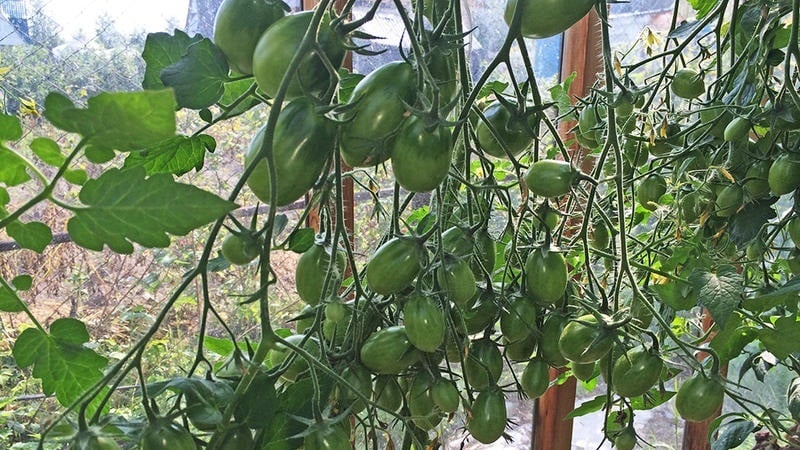
Selection of containers and soil
For sowing seeds, choose large, shallow containers. Gardeners often use improvised materials for these purposes, for example, plastic dishes and packages of semi-finished products.
Plastic and peat pots, disposable cups and cut-off bottles are used as individual containers for seedlings.
Advice. A 5-liter bucket of small berries is collected from one Pink raisin bush. Most gardeners plant only 2-3 bushes of this hybrid. In this case, it is better to sow the seeds in individual peat tablets.
Containers for sowing seeds are disinfected by soaking for half an hour in a strong solution of potassium permanganate. Sterilizing pots with boiling water is no less effective.
Many gardeners prefer to make their own soil for tomatoes. To do this, take soil from the beds where adult tomatoes will grow. It is mixed in equal proportions with peat and humus. If the acidity of the soil is increased, add ash. Take a glass of ash for one bucket of soil mixture.
The soil mixture is also sold in specialized stores. It contains all the necessary microelements.
The soil for growing seedlings is disinfected in one of the following ways:
- pouring boiling water;
- watering with a dark pink solution of potassium permanganate;
- calcination in the oven or microwave.
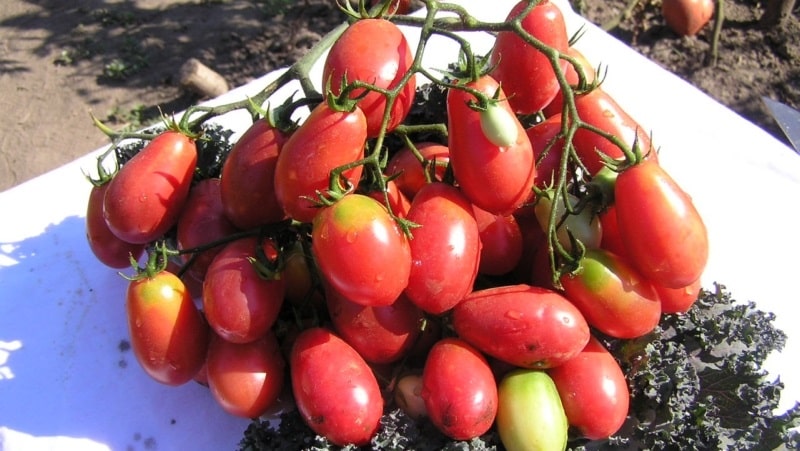
Sowing seeds
The boxes are filled with soil mixture, which is abundantly moistened with warm water. Grooves 1 cm deep are made in the soil at a distance of 3 cm. Seeds are placed in them at intervals of 1.5-2 cm. The planting material is sprinkled with a layer of earth without compacting.
The containers with seeds are covered with film and put in a warm place. It doesn't have to be well lit. Seeds do not need sunlight before germination.
When sowing in peat tablets, they are pre-soaked in boiling water, placing them in a container with the holes facing down. When the workpieces swell, they are removed from the container. The planting material is buried in the peat using a toothpick. All tablets are placed in one container, which is covered with film and put in a warm place.
Seedling care
Grow seedlings It’s not difficult to grow tomatoes yourself if you follow the basic rules for caring for them:
- When the first shoots appear, the film is removed. Plants are moved to a well-lit place. If natural light is not enough, use a fluorescent lamp.
- Experienced gardeners advise, after seed germination, to remove tomatoes for a week in a cool place with a temperature of 16-17 ºC. Then the seedlings are placed in heat again. This prevents plants from stretching out prematurely.
- The soil is moistened as it dries (on average 3 times a week). Use only settled water at room temperature. The liquid should not fall on the above-ground part of the plants.
- It is important that the seedlings do not stand in a draft. Otherwise, fragile plants will simply die.
- If the seeds are sown in a common container, after the first true leaves appear, the seedlings are planted in individual pots.Drainage must be placed at the bottom of tomato containers.
- After transplantation, the seedlings are not fed or watered for 10 days.
- Tomatoes are fed 3 times during the period of growing seedlings. Use organic and complex fertilizers with phosphorus.
- 2 weeks before planting in a permanent place, the seedlings are hardened off by taking them out into the fresh air. Hardening begins at half an hour, gradually increasing the time.
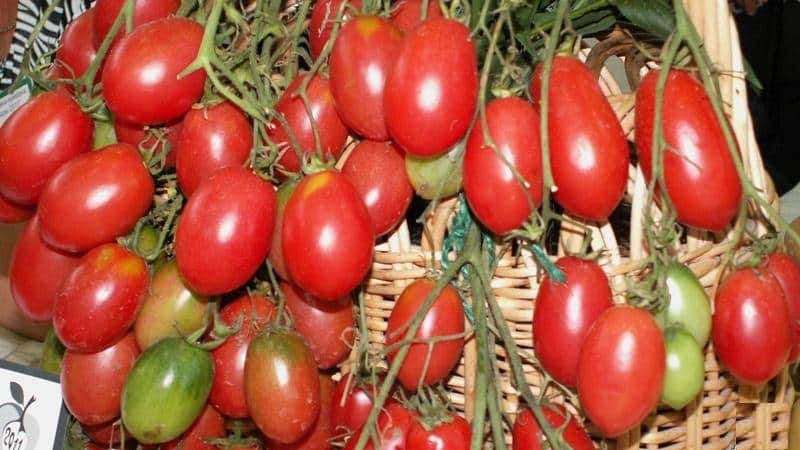
Agricultural technology of Pink raisins
Seedlings are planted in the ground when the soil warms up. For early-ripening tomatoes, it is especially important to adhere to the timing of picking. If you keep seedlings in pots, it will be more difficult for them to adapt after picking.
The time for planting the Pink Raisin tomato depends on the climatic conditions of the region. The further north the city is, the later the seedlings are planted in open ground.
Planting tomatoes in a permanent place
When choosing a site for growing tomatoes, it is important to consider several nuances:
- Tomatoes are light-loving plants. For them, choose a plot of the garden that is in the open sun.
- Tomatoes should not be planted in beds where nightshade crops have grown for the past 3 years. The best precursors for tomatoes are legumes, melons, onions, and cucumbers.
- It is important to choose the right neighbors for tomatoes. Potatoes should not be planted near the tomato beds. If tomatoes are grown in a greenhouse, no other plants are planted in the same room.
It is important to properly prepare tomato beds. They are dug up and cleared of plant debris and roots. To enrich the soil, add cow manure, chicken manure or humus. To reduce the acidity of the soil, add ash or dry lime.
Holes 25-30 cm deep are dug in staggered rows. For 1 sq. m place no more than 3 plants.A handful of ash and long-acting granular complex fertilizers are poured into each cavity.
2-3 days before planting in the ground, water the tomatoes and feed. Directly during picking, the plants are removed from the pots and placed in the holes, slightly deepening the stem.
The soil around the tomatoes is compacted. Tomatoes are watered using 1 liter of warm water for each plant.
Further care
Tie up Pink raisin bushes are needed. To do this, use strong supports with a height of at least 1.5 m. The garter thread should be made of synthetic fibers. It will not rot or damage the stems of the plant.
Tomatoes are formed into 2-3 stems. The more stems left, the more abundant the harvest will be, but the later the fruits will ripen.
In progress stepsons The lower leaves up to the first cluster are also removed. This procedure is carried out once a week. It is also necessary to get rid of withered and yellowed greenery.
Tomatoes are watered 2-3 times a week. For 1 plant use 2-2.5 liters of water. This procedure is carried out early in the morning or at sunset.
After each watering, the soil is loosened. The beds are weeded weekly.
Fertilizing is applied 3-4 times per season. Alternate mineral and organic fertilizers. If long-acting granules are first poured into the holes, the number of feedings is reduced to 2.
Foliar feeding apply 1-2 times. Use products containing boron.
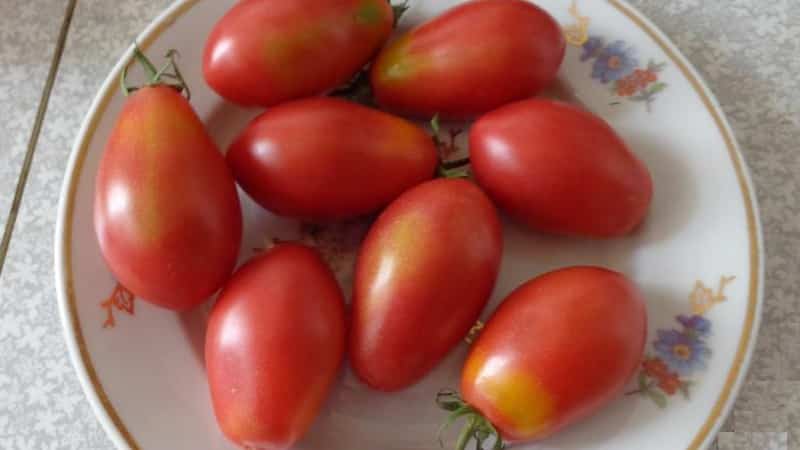
Nuances of cultivation
When cultivating Pink Raisin tomatoes, it is important to consider several nuances of growing this hybrid:
- Pink raisin clusters are heavy due to the large number of fruits. If they lean towards the ground, use additional support.
- This tomato takes up a lot of space.Gardeners advise setting aside a separate corner in the greenhouse for the bush.
- If the bushes produce a lot of greenery and few fruits, it means that the tomato is faced with an overabundance of fertilizers.
- Incorrectly formed inflorescences are removed.
- To help fruit set, Pink Raisin bushes are shaken regularly.
Diseases and pests
Hybrid Pink raisins are resistant to most tomato diseases. But this does not mean that if the rules of prevention are not followed, an infection will not strike him.
Advice. To reduce the likelihood of tomatoes becoming infected in a greenhouse late blight, an open vial of iodine is broadcast in the room.
It is important to avoid infection on tomatoes. Fungal and viral pathogens multiply in the soil, on seedling pots and garden tools. Disinfection will help get rid of them.
To prevent plants from being damaged by insects (whiteflies, aphids, mites), plants are sprayed with purchased products (Confidor, Actellik, Fufanon) and home remedies.
Features of cultivation in open and protected ground
The walls of the greenhouse in which the tomatoes will grow are treated with a disinfectant composition. Typically, copper sulfate or a strong solution of potassium permanganate is used as a disinfectant.
Greenhouses are regularly ventilated - this increases productivity and reduces the risk of damage by pathogenic microorganisms.
To protect tomatoes from pests, mosquito nets are installed on the greenhouse windows. Insect traps are also used.
For more efficient pollination, a fan is placed in the greenhouse.
In open ground, it is important to protect plants from night frosts. To do this, they are covered with film for the first two weeks after planting.
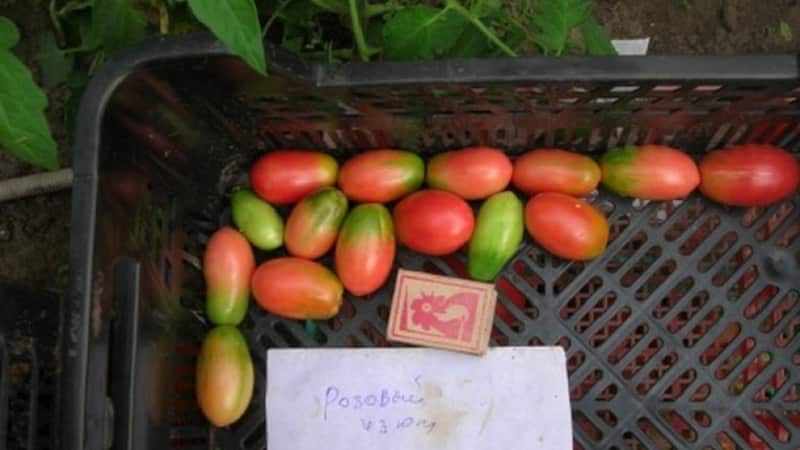
Harvesting and application
Pink Raisin tomatoes begin to be harvested at the end of June. They are distinguished by their rapid ripening, so the harvest is harvested with tassels.
The hybrid berries are stored on the bushes and at room temperature for a long time. They ripen at home without losing their taste.
Pink raisins are universal in gastronomic terms. It is suitable for fresh consumption, freezing and canning whole. These cherry tomatoes are dried and rolled in their own juice.
Advantages and disadvantages
Advantages of a hybrid:
- high productivity;
- great taste;
- early ripeness;
- ease of care;
- versatility of use;
- immunity to tomato diseases.
There were no deficiencies found in Pink Raisins.
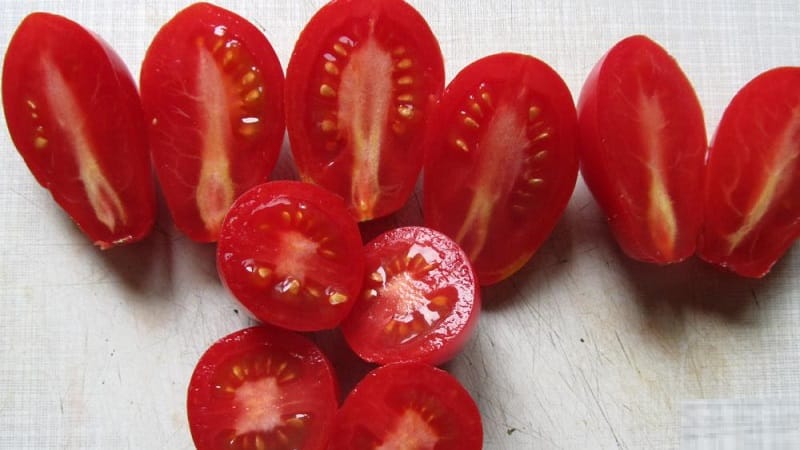
Farmers' reviews of the hybrid
Pink raisins have good reviews from gardeners. It is suitable for cultivation for personal use and for sale.
Irina, Moscow: “I’ve been growing pink raisins in a greenhouse for 5 years now. I plant only 3 bushes. I collect almost 20 kg of tomatoes from them. A very prolific hybrid. It must be taken into account that its bushes take up a lot of space. The tomatoes taste good, especially for an early ripening variety.”
Mikhail, Belgorod: “After reading positive reviews, I planted Pink Raisins in open ground and was not disappointed! Excellent cherry tomatoes, pink and oblong, as in the photo. I was pleased with the yield and the taste too. Bushes formed into 1 and 2 stems. For this hybrid, the second option is more suitable. We tried the first tomatoes in June.”
Conclusion
Tomato Pink raisin will appeal to those who prefer pink-fruited small tomatoes with high yield.
In addition to the amazing taste and appearance of the fruit, Pink raisins are distinguished by their early ripening and ease of care.It is worth the attention of both experienced and novice gardeners.